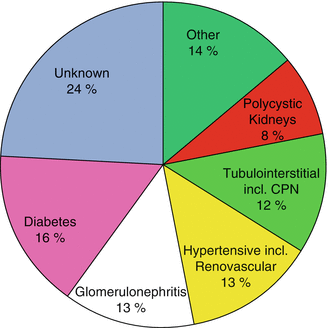and Christopher Isles2
(1)
Institute of Cardiovascular and Medical Sciences, University of Glasgow, Glasgow, UK
(2)
Dumfries and Galloway Royal Infirmary, Dumfries, UK
Q1 What is meant by the term chronic kidney disease?
A good working definition is an irreversible deterioration in renal function that develops over a period of months to years. This distinguishes chronic kidney disease from acute kidney injury which is best thought of as a deterioration in renal function, sometimes reversible and sometimes not, that develops over a period of hours to days. The current official definition of CKD includes all people with markers of kidney damage and those with GFR of less than 60 ml/min on at least 2 occasions separated by a period of at least 90 days. Markers of kidney damage are ACR more than 3 mg/mmol, urine sediment abnormalities, electrolyte and other abnormalities due to tubular disorders, abnormalities detected by histology, structural abnormalities detected by imaging and a history of kidney transplantation.
Q2 How common is chronic kidney disease?
The prevalence of CKD rises sharply with age and the frequency with which it is recognised has increased, some would argue artefactually, as a result of the widespread use of eGFR. For more details on how CKD is classified using the GFR see Chap. 2. Many elderly people are now classified as having CKD3 with eGFR 30–59 ml/min simply because of the formula used to calculate eGFR. Few of us would consider a person of 85 years of age with serum creatinine 120 umol/l to have chronic kidney disease any more than we would suggest that an elderly man or woman who had become slightly more breathless on exertion necessarily had chronic lung disease. Nephrons – like alveoli – have a tendency to wither with age. By complete contrast a serum creatinine of 120 umol/l in a teenager ought to set alarm bells ringing. These qualifications aside, the prevalence of CKD3 in the general population as determined by eGFR is around 5 % and that of CKD 4 and 5 around 0.2 % and 0.1 % respectively.
Q3 What are the symptoms of chronic kidney disease?
Many patients with chronic kidney disease are asymptomatic which means that their renal failure is only picked up when they have blood tests for something else. For patients who do have symptoms, many are non-specific, including nocturia, tiredness, and breathlessness. Anorexia and nausea indicate that dialysis may shortly be required in a patient whose renal failure is progressing, particularly if associated with weight loss. Generalised itch, often with scratch marks, and restless legs are more specific for chronic kidney disease than nocturia, tiredness and breathlessness, though they are not always present. Late symptoms, which one would hopes never to see, include hiccups, muscular twitching, fits, drowsiness and coma. The term ‘uraemia’ is usually taken to mean a high level of urea (often greater than 30 mmol/l) with loss of appetite, nausea or vomiting.
Box 20.1 Five symptoms that suggest progressive renal failure
1.
Loss of appetite
2.
Nausea
3.
Breathlessness
4.
Generalised itch
5.
Restless legs
Q4 What are the signs of chronic kidney disease?
There aren’t very many in the early stages of CKD. Oedema raises possibility of nephrotic syndrome but has numerous other causes. Palpable kidneys suggest autosomal dominant polycystic kidneys (ADPKD) but inability to feel one or both kidneys does not exclude this diagnosis. Increased bladder dullness is a useful and underrated sign in a patient with bladder neck obstruction. Patients with advanced CKD may be pale due to anaemia, pigmented due to uraemia and have scratch marks as a result of their pruritus. A pericardial friction rub means that it is time to start dialysis.
Box 20.2 Five signs that may be present in CKD
1.
Oedema
2.
Palpable kidneys (ADPKD)
3.
Increased bladder dullness
4.
Skin changes – pallor, pigmentation, scratch marks
5.
Pericardial friction rub
Q5 What are the common causes of chronic kidney disease?
The pie chart shows the distribution of causes of all 533 patients who started renal replacement therapy in Scotland in 1999. Diabetes, glomerulonephritis and hypertensive renal diseases including renovascular disease were the three most frequently identified causes. Scottish Renal Registry data show that the causes of CKD requiring dialysis today are very similar to those of 1999. Diabetes accounts for up to 40 % of the causes of kidney failure in patients on dialysis in some parts of the world. Glomerulonephritis is a term used to describe a number of disorders, most of them immunologically mediated, that primarily affect the glomeruli leading to chronic renal failure. The hallmark of glomerular disease is proteinuria. When hypertension causes kidney failure this is usually because of narrowing of the small blood vessels within the kidney, so called hypertensive nephrosclerosis. Renovascular disease and malignant hypertension are two other ways in which patients with hypertension may develop chronic renal failure (Fig. 20.1).






Fig. 20.1
Causes of chronic kidney disease (Metcalfe W et al. Equity of renal replacement therapy utilization: a prospective population-based study. QJM: An International Journal of Medicine. 1999;92;637–42, by permission of Oxford University Press)
< div class='tao-gold-member'>
Only gold members can continue reading. Log In or Register to continue
Stay updated, free articles. Join our Telegram channel

Full access? Get Clinical Tree








